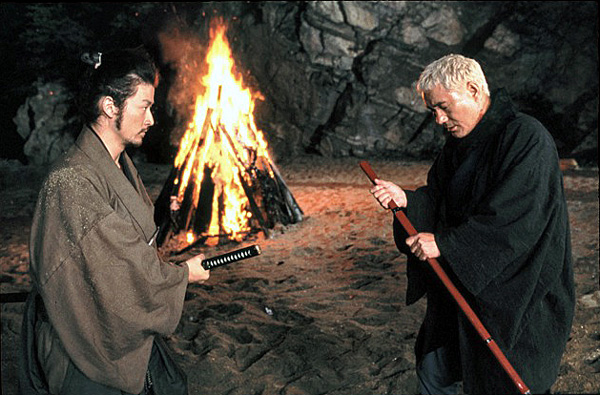|
Though I’ve never met him, Takeshi Kitano is one of my favorite people. Comedian, painter, author, actor, director,
screenwriter–he has achieved success in all these endeavors individually, but it is in the films in which he both acts and directs that he weaves his arts together. The
result is bracing, often startling cinema; Kitano serves up the world in ways to make you see it again.

The Japanese have had the good fortune to get to know Kitano through his decades of television and radio performance, as well
as his movies. Born in 1947, he first appeared on TV in 1976, subsequently zooming to national fame as half of a comedic duo
called Two Beat. Kitano and his friend, Kiyoshi Kaneko, became “Beat Takeshi” and “Beat Kiyoshi,” a likeable pair of ordinary
young men who banter at a rate to make Abbott & Costello’s “Who’s On First” routine sound like an exchange in a retirement home.
My admiration for this multi-faceted artist (is there a Japanese equivalent for the concept “Renaissance man”?) rests on three
films: Sonatine, HANA-BI, and ZatÅichi. Kitano wrote, directed, and starred in all three (he even edited the first two and co-edited ZatÅichi.)
In his 1993 film Sonatine, Kitano portrays Murakawa, a Tokyo yakuza sub-captain, or in American Mafia parlance a caporegime. He and his crew are sent on a mission to Okinawa. What is
billed as a show of strength to aid negotiations turns bloody, forcing Murakawa and his surviving men to hide out in a safe house on the ocean.
It is here, in a seaside idyll, that the movie takes off, not with violence but camaraderie and beauty. Starting as a tense
stillness, the interlude goes on and on, beguiling the viewer, like Murakawa and his men, to relax. While waiting for hostilities to
blow over, the men occupy themselves with meals, games, pranks, singing, and even traditional Japanese dancing. Kitano’s
irrepressible, mischievous humor permeates the segment.
Murakawa shows his men how to make origami figures. By placing the figures upright on a small board and lightly tapping it
, the figures can be made to move and “fight.” At the beach one day, the idea re-emerges, transformed by Kitano as director into
a magical segment heightened by the music of his longtime collaborator Joe Hisaishi. The men have fashioned a sumo wrestling ring, but instead of grappling they stand frozen in
ready positions (like the origami figures) while their friends outside the ring “move” them by slapping the beach sand. Kitano
uses stop-motion photography to show the “matches,” the men bumping and spinning in random directions a frame at a time.
It’s a scene that completely blindsides the viewer with charm. Such unexpected transport is Kitano’s calling card.
In Japanese, HANA-BI means “fireworks” and it could be said that Kitano exploded onto the international scene with this
movie, garnering a Golden Lion for best picture at the 1997 Venice Film Festival.
Beginning on the other side of the law, Kitano is Nishi, a detective haunted by an arrest-gone-wrong that results in
paralysis for his partner, Horibe. After quitting the police department, Nishi learns that his wife has leukemia. He turns to
the yakuza for financial help then pulls off an exquisitely slick bank heist to pay them. But when the yakuza realize that Nishi
was the bank robber, they pursue him for a cut despite his repeated demonstrations of the folly of their greed.
As in Sonatine, the violence in HANA-BI occurs with dazzling
swiftness. At one point, Kitano sits–facing the camera–at a sushi bar, immobile and utterly expressionless, a mode he has
developed into a signature look and one in striking contrast to the animated comedian of an earlier era. When his yakuza
pursuers sit on either side of him, he doesn’t twitch. Then, in a “fight” scene that lasts about three seconds, Nishi dispatches
both men with the chopsticks he’d used to eat his meal. If you sneezed you could miss the demise of both thugs.
But even more than Sonatine, Kitano has mesmerizing surprises in store.
Prompted by a conversation with his old partner, Nishi anonymously sends Horibe a box of art supplies, as well as a
black beret (a touching gesture so that Horibe can look the proper artist.) Horibe begins making pointillist drawings with
markers. Then, in a sublime cross-cut, Nishi prepares for his bank robbery by spray-painting a car to look like a police cruiser
while somewhere else in Tokyo Horibe parks his wheelchair in front of a florist’s display, transfixed with creative visions induced by the flowers.
Joe Hisaishi’s accompanying soundtrack parallels the cross-cut, moving from a theme of methodical intent at clockwork tempo to
ravishing pathos in waves of opulent strings.
As Horibe looks at different flowers, finished canvases take form in his mind and on screen: sunflowers become a diving owl’s
eyes; lilies change into cat’s eyes, an orca’s eyespots, and yet again into the heads of penguins; orchids serve as the heads of
bats, dragonflies, and a plump caterpillar on a leaf; a pale anthurium replaces the menacing horns of a rhinoceros.
Once again, Kitano, in concert with Hisaishi’s suave elegance, stuns the viewer, not only with the material itself, but also in
relation to the film’s supposed genre, ostensibly a cops-and-yakuza action flick. And there’s an additional surprise: the
paintings, rendered in vibrant colors and each one more surprisingly clever than the last, are actually by Kitano!
In 2003, Kitano took an unexpected turn, departing from the modern-day yakuza variations that comprised five of his first ten
films as director to portray the blind swordsman of the late Edo-period, ZatÅichi, a beloved fictional character of Japanese film and television.
At the Venice Film Festival that year, Kitano was rewarded with a Silver Lion for best director. He could have won for best actor
just as easily; Kitano’s immersion in the character, from the nuanced gestures and body language of blindness to the
masterful but altogether believable swordplay, is superb.
And even within his loving homage to a samurai classic, Kitano, in his many moods and modes, finds ways to stamp his
imprimatur. Amidst flashes of gore and a chilling back-story to the geishas ZatÅichi defends, “Beat Takeshi” makes you laugh
while artist and director Takeshi Kitano takes your breath away. The movie seems to end with ZatÅichi carving up a platoon of
rank and file bad guys, dispatching the crackerjack ronin in a much-awaited duel, and, poetically, blinding–instead of killing–the chief villain.

But Kitano has something different in mind–as always. What looks like a village festival to celebrate the villains’ demise turns
into a gleefully anachronistic, all-out tap dance extravaganza worthy of the biggest Broadway stage. Kitano employed The
Stripes, a Japanese progressive tap dance troupe, and let their artistic director, Hideboh, choreograph a routine. Speaking about his collaboration on ZatÅichi, Hideboh said, “our dance
was a transformation of Japanese crop work into American tap.”
The dancers wear traditional kimonos and wooden clogs. Many brandish walking staffs. Taiko drummers pound out a furious
street rhythm as the troupe keeps percussive time with their clogs, clapping hands, and clacking sticks. Whoops and hollers
fly as these men and women joyfully strut their stuff. I’m no fan of musicals and Broadway productions, but this finale just
floored me. Its unexpectedness, its sheer exuberance–I never saw it coming.
Blindsided again by the many arts of Takeshi Kitano….
|